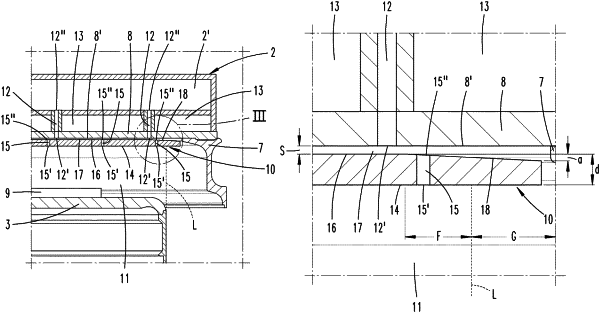| CPC C23C 16/45565 (2013.01) [C23C 16/4557 (2013.01); C23C 16/45572 (2013.01); H01J 37/3244 (2013.01); H01J 37/32449 (2013.01); H01J 2237/3321 (2013.01)] | 6 Claims |

|
1. A chemical vapor deposition (CVD) reactor comprising:
a process chamber (11);
a gas inlet member (2) having a first circular outline, the gas inlet member (2) having a ceiling panel (8) facing towards the process chamber (11), wherein the ceiling panel (8) has outlet openings (12′) and is cooled;
a heating device (4);
a susceptor (3) that is heated by the heating device (4), a radially outermost edge of the susceptor (3) defining a cylindrical shell surface boundary (L); and
a shield plate (10), adjacent to the ceiling panel (8), having a second circular outline,
wherein the shield plate (10) has a central zone, an annular zone (18) surrounding the central zone, a rear face (16) facing towards the ceiling panel (8), and a first gas outlet surface (14) facing towards the process chamber (11), into which gas outlet openings (15) of the shield plate (10) lead,
wherein the first gas outlet surface (14) is planar,
wherein the rear face (16) in the central zone defines a rear plane extending parallel to the first gas outlet surface (14),
wherein the rear face (16) has structures (18, 19, 20) configured to influence (i) a thermal coupling of the shield plate (10) to the ceiling panel (8), and/or (ii) a heat flow through the shield plate (10),
wherein the structures (18, 19, 20) form at least one elevation or one depression, with respect to the rear plane,
wherein the shield plate (10) has a material thickness (d) that is defined by a distance between the first gas outlet surface (14) and the rear plane, with the material thickness (d) in a first range from 3 to 12 mm,
wherein in the annular zone (18), the material thickness (d) of the shield plate (10) continuously decreases in a radial direction pointing away from a center of the shield plate (10),
wherein the cylindrical shell surface boundary (L) intersects the annular zone (18) such that a radially inner region (F) of the annular zone (18) extends radially inwards from the cylindrical shell surface boundary (L) towards the center of the shield plate (10), and a radially outer region (G) of the annular zone (18) extends radially outwards from the cylindrical shell surface boundary (L) away from the center of the shield plate (10), and
wherein the shield plate (10) is spaced apart from a second gas outlet surface (8′) formed by the ceiling panel (8) by a gap (17), defined by a distance between the second gas outlet surface (8′) and the rear plane, with a height (S) of the gap (17) in a second range from 0.3 to 1 mm.
|